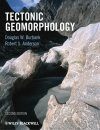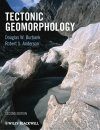Textbook
By: D Burbank and R Anderson
274 pages, 120 illus, figs, maps
![Tectonic Geomorphology Tectonic Geomorphology]()
Click to have a closer look
About this book
Contents
Customer reviews
Biography
Related titles
About this book
Tectonic geomorphology is the study of the interplay between tectonic and surface processes that shape the landscape in regions of active deformation and at time scales ranging from days to millions of years. Over the past decade, recent advances in the quantification of both rates and the physical basis of tectonic and surface processes have underpinned an explosion of new research in the field of tectonic geomorphology. Modern tectonic geomorphology is an exceptionally integrative field that utilizes techniques and data derived from studies of geomorphology, seismology, geochronology, structure, geodesy, stratigraphy, meteorology and Quaternary science.
While integrating new insights and highlighting controversies from the ten years of research since the 1st edition, this 2nd edition of Tectonic Geomorphology reviews the fundamentals of the subject, including the nature of faulting and folding, the creation and use of geomorphic markers for tracing deformation, chronological techniques that are used to date events and quantify rates, geodetic techniques for defining recent deformation, and paleoseismologic approaches to calibrate past deformation.
Overall, this book focuses on the current understanding of the dynamic interplay between surface processes and active tectonics. As it ranges from the timescales of individual earthquakes to the growth and decay of mountain belts, this book provides a timely synthesis of modern research for upper-level undergraduate and graduate earth science students and for practicing geologists.
Contents
1. Introduction 2. Dating the Quarternary Record 3. Geomorphologic Markers and the Climatic Record 4. Nature of climate change 5. Deformation at short time scale 6. Fluvial responses to active tectonics 7. Deformation and geomorphology at intermediate time scales 8. Long time scale deformation and geomorphology 9. Rates of erosion, uplift, denudation, and subsidence 10. Modeling of landscapes
Customer Reviews
Biography
Douglas Burbank is a tectonic geomorphologist who investigates the growth of mountains and evolution of landscapes primarily in collisional mountain belts, ranging from New Zealand's Southern Alps to the Tien Shan and the Andes. He has focused on interactions among mountain building, erosion, climate, and deposition at time scales ranging from decades to millions of years. Robert Anderson is a geomorphologist who has studied the processes responsible for shaping many landscapes. These include several tectonically active mountain ranges, from the Himalayas to Alaska. He has been involved deeply in the development of methods to extract timing from landscapes, focusing on the use of cosmogenic radionuclides, and consistently employs numerical models in his work.
Textbook
By: D Burbank and R Anderson
274 pages, 120 illus, figs, maps
Let me end by highly praising this important book, complimenting the authors and urging all geoscientists to have a copy on their shelves. Geological Magazine "Although this book does not provide a detailed manual of all the techniques which bear on environmental change, it does give a valuable introduction, and, more importantly, places this in the context of the longer-term interactions." Mike Kirkby, The Holocene, April 2002




































